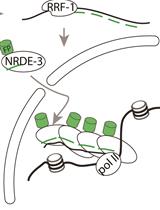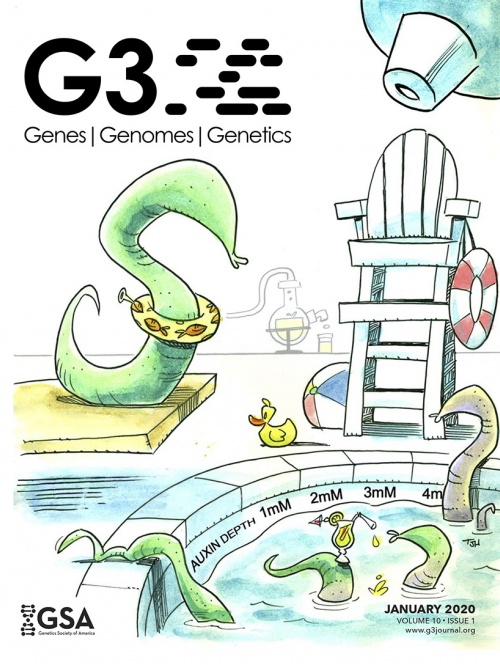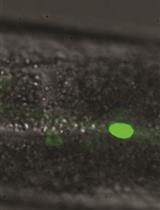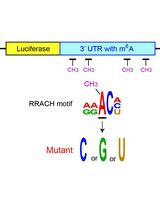- EN - English
- CN - 中文
Auxin-mediated Protein Degradation in Caenorhabditis elegans
生长素介导的秀丽隐杆线虫蛋白质降解
发布: 2020年04月20日第10卷第8期 DOI: 10.21769/BioProtoc.3589 浏览次数: 5683
评审: Gal HaimovichManish ChamoliJian Chen

相关实验方案

用Argonaute NRDE-3标记活性转录位点—图像秀丽隐杆线虫体内的活性转录位点
Antoine Barrière and Vincent Bertrand
2022年06月05日 2636 阅读
Abstract
The auxin-inducible degron (AID) technology was recently adapted for use in the nematode Caenorhabditis elegans. Rapid degradation of C. elegans proteins tagged with an AID is mediated by a plant-specific F-box protein, transport inhibitor response 1 (TIR1), and occurs only in the presence of the phytohormone auxin. The first iteration of this technology elicited protein degradation in C. elegans through a naturally occurring form of auxin, indole-3-acetic acid (IAA). Here, we present a protocol that uses 1-naphthaleneacetic acid, potassium salt (K-NAA), an indole-free synthetic auxin analog. At equal concentration, K-NAA is as effective as IAA in standard nematode growth media (NGM). K-NAA is also effective in physiological buffer (M9), allowing for high-throughput experimentation. The main advantages of K-NAA are twofold: first, its photostability prevents light-induced compound degradation during storage and the production of toxic indole-derivatives during fluorescence microscopy of live cells; and second, its water solubility eliminates the need of using ethanol to dissolve the auxin compound, a solvent that may confound C. elegans lifespan and behavioral assays. In this protocol, we describe our method of degrading C. elegans proteins using K-NAA on solid and in liquid media, as well as our method of analyzing protein degradation.
Keywords: AID technology (AID技术)Background
Conditional protein degradation through degrons is an emerging method for studying protein function in Caenorhabditis elegans (Nance and Frøkjær-Jensen, 2019). Current degron methods include ZF1 (Armenti et al., 2014; Sallee et al., 2018), auxin-inducible degron (AID) (Zhang et al., 2015; Martinez et al., 2019), and GFP nanobody-mediated protein degradation (Wang et al., 2017). Originally, the auxin-based degron method was co-opted from plants and transplanted into nonplant systems such as yeast, chicken and mammalian cell culture (Nishimura et al., 2009). This method was recently optimized for use in C. elegans due to advances in CRISPR/Cas9 gene-editing technology (Zhang et al., 2015; Dickinson and Goldstein, 2016). In the presence of the plant hormone auxin, C. elegans proteins tagged with an AID are rapidly degraded by a heterologously expressed plant-specific F-box protein, transport inhibitor response 1 (TIR1). TIR1 functions as a substrate-recognition component of the CUL-1-based SCF E3 ubiquitin ligase complex consisting of SKR-1/2, CUL-1 and the RING component RBX-1 (Martinez et al., 2019). In as little as 30 min, C. elegans proteins exposed to auxin can be precisely degraded in a tissue- and cell-specific manner (Zhang et al., 2015; Martinez et al., 2019).
Either the natural auxin indole-3-acetic acid (IAA) or the synthetic auxin 1-naphthaleneacetic acid (NAA) can be used to conditionally deplete target proteins (Zhang et al., 2015; Martinez et al., 2019). However, NAA has the advantage over IAA partly due to its photostability (Yamakawa et al., 1979). Blue light, used to excite GFP, in combination with IAA has been shown to cause defects in mitosis and meiosis in yeast and mammalian oocytes, respectively (Papagiannakis et al., 2017; Camlin and Evans, 2019). Such effects likely occur through the photo-destruction of IAA to its toxic indole derivatives (Folkes and Wardman, 2001; Srivastava, 2002). Furthermore, the potassium salt of NAA (K-NAA) has the extra advantage of being completely water-soluble. This circumvents the need to expose C. elegans to low percentages of ethanol, used to dissolve IAA, or other potentially harmful solvents (Li et al., 2019). Additionally, when compared to 4 mM IAA, an equivalent concentration of K-NAA does not affect growth of C. elegans bacterial food Escherichia coli OP50 (Martinez et al., 2019). Also, 4 mM IAA results in significant embryonic lethality compared to K-NAA of the same concentration (Martinez et al., 2019). Potential applications of this protocol include high-throughput, high-resolution chemical genetic screens using a microfluidic device or a 96-well plate where worms are immersed in K-NAA. The protocol described here will elaborate on a simple procedure where C. elegans larvae are immersed in K-NAA diluted in M9 physiological buffer on a spot plate or exposed to K-NAA diluted in traditional nematode growth media (NGM). Finally, a step-by-step procedure to quantify the extent of protein degradation is presented.
Materials and Reagents
- Laboratory labeling tape
- 60 x 15 mm medium size Petri dish (Crystalgen, catalog number: S-3004 )
- 90% platinum, 10% iridium wire (Tritech Research, catalog number: PT-9010 )
- 0.1-10 μl micropipette tips (VWR, catalog number: 46620-316 )
- 1-200 μl micropipette tips (VWR, catalog number: 53508-783 )
- 100-1,250 μl micropipette tips (VWR, catalog number: 53508-918 )
- 15 ml centrifuge tubes (Thermo Fisher Scientific, catalog number: 339650 )
- 50 ml centrifuge tubes (VWR, catalog number: 89401-572 )
- 30 ml syringe (Fisher Scientific, catalog number: 309650 )
- Sterile syringe filter, 5 μm, 25 mm (Pall, catalog number: 4199 )
- Spot plate (Thomas Scientific, catalog number: 7812G17 )
- 9 ml glass culture tubes (VWR, catalog number, 47729-572 )
- 2 ml glass pipette (VWR, catalog number: 14673-043 )
- 18 x 18 mm, #1.5 thickness microscope cover slip (Fisherbrand, catalog number: 12-541A )
- 25 x 75 x 1.0 mm microscope slides (Fisherbrand, catalog number: 12-550-A3 )
- Paper towels
- 1.5 ml microcentrifuge tubes
- Worm pick handle (Tritech Research, catalog number: TWPH1 )
- Escherichia coli OP50 (University of Minnesota, Caenorhabditis Genetic Center)
- Caenorhabditis elegans CA1202 (control strain for auxin-inducible degradation experiments in somatic tissues) (University of Minnesota, Caenorhabditis Genetic Center, genotype: ieSi57[eft-3>TIR1::mRuby] II; ieSi58[eft-3>AID::GFP] IV)
- 6.0% sodium hypochlorite solution (Ace Hardware, catalog number: 1912120 )
- Naphthaleneacetic acid (K-NAA) (PhytoTechnology Laboratories, catalog number: N610 )
- Mounting agar (VWR, catalog number: 0 815 )
- Sodium azide (NaN3) (Sigma-Aldrich, catalog number: S2002 )
- Sodium chloride (NaCl) (Fisher Scientific, catalog number: S271-3 )
- Peptone (Thermo Fisher Scientific, catalog number: 211677 )
- Bacteriological agar (Lab Scientific, catalog number: A466 )
- 100% ethanol (Pharmco, catalog number: 111000200 )
- Double-distilled water (ddH2O)
- Potassium hydroxide (KOH) (BioExpress, catalog number: 0489)
- Cholesterol (BioExpress, catalog number: 0433 )
- Calcium chloride (CaCl2) (Fisher Scientific, catalog number: C79-500 )
- Magnesium sulfate (MgSO4) (Fisher Scientific, catalog number: M63-500 )
- Monopotassium phosphate (KH2PO4) (Fisher Scientific, catalog number: BP362 )
- Dipotassium phosphate (K2HPO4) (Fisher Scientific, catalog number: BP363 )
- Disodium phosphate (Na2HPO4) (Fisher Scientific, catalog number: S374 )
- 5 M KOH stock solution (see Recipes)
- 5 mg/ml cholesterol (see Recipes)
- 1 M CaCl2 stock solution (see Recipes)
- 1 M MgSO4 stock solution (see Recipes)
- 1 M KPO4, pH 6.0 stock solution (see Recipes)
- 250 mM K-NAA stock solution (see Recipes)
- Nematode growth media (NGM) plates (see Recipes)
- NGM plates containing K-NAA (see Recipes)
- 1x M9 buffer (see Recipes)
- K-NAA in 1x M9 buffer (see Recipes)
- 5% agarose (see Recipes)
- 1 M NaN3 stock solution (see Recipes)
- Agarose containing NaN3 (see Recipes)
- Agarose pad containing NaN3 (see Recipes)
Equipment
- 0.1-2 μl micropipette (Thomas Scientific, catalog number: P3960-2A-B )
- 2-20 μl micropipette (Thomas Scientific, catalog number: P3960-20A-B )
- 20-200 μl micropipette (Thomas Scientific, catalog number: P3960-200A-B )
- 100-1,000 μl micropipette (Thomas Scientific, catalog number: P3960-1000A-B )
- Rubber pipette bulb (Thomas Scientific, catalog number: 1951F25 )
- Microwave
- Bunsen burner
- Scale
- 250 ml storage bottles
- 500 ml storage bottles
- 1 L storage bottles
- 4 L Erlenmeyer flask
- Magnetic stirring bar
- Autoclave
- Stir plate (Corning, model: PC-310 )
- Vortex mixer (VWR, catalog number: 10153-838 )
- Microcentrifuge (Eppendorf, model: Centrifuge 5424 )
- Benchtop centrifuge (Beckman Coulter, model: Allegra X-12R )
- Tube rocker (Benchmark Scientific, model: M2100 )
- Dry bath incubator (Fisher Scientific, catalog number: 11-718 )
- Dissecting microscope (Zeiss, model: Stemi 508 )
- EM-CCD camera (Hamamatsu, model: C9100-23B )
- Spinning disk confocal microscope (Yokogawa, model: CSU10 )
Software
- ImageJ (version: 2.0.0-rc-69/1.52p)
Procedure
文章信息
版权信息
© 2020 The Authors; exclusive licensee Bio-protocol LLC.
如何引用
Martinez, M. A. Q. and Matus, D. Q. (2020). Auxin-mediated Protein Degradation in Caenorhabditis elegans. Bio-protocol 10(8): e3589. DOI: 10.21769/BioProtoc.3589.
分类
发育生物学 > 形态建成 > 器官形成
发育生物学 > 细胞生长和命运决定 > 分化
分子生物学 > 蛋白质 > 靶向降解
您对这篇实验方法有问题吗?
在此处发布您的问题,我们将邀请本文作者来回答。同时,我们会将您的问题发布到Bio-protocol Exchange,以便寻求社区成员的帮助。
Share
Bluesky
X
Copy link












